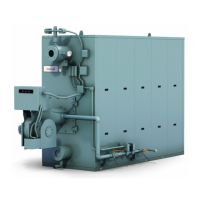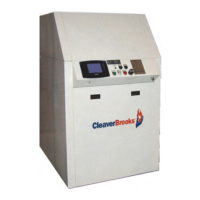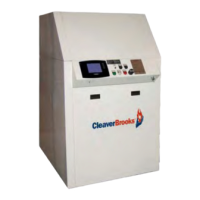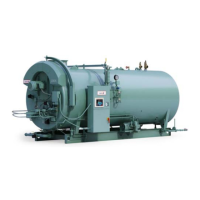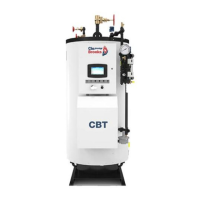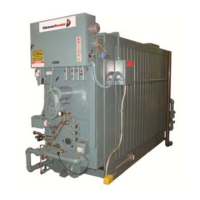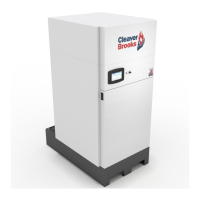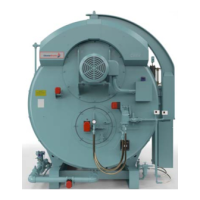Chapter 6 Adjustment Procedures
6-8 750-177
ADJUSTMENT
After operating for a sufficient period of time to assure a
warm boiler, adjustments should be made to obtain efficient
combustion.
Burner efficiency is measured by the amount or percentage of
O
2
present in the flue gas. O
2
readings determine the total
amount or excess air in the combustion process, above the
point of stoichiometric combustion or perfect combustion.
Stoichiometric combustion is a term used to describe a
condition when there is the exact amount, molecule for
molecule, of air for the fuel attempting to be burned. This can
be accomplished under laboratory conditions, however it’s
not practical to attempt to meet this condition in a boiler.
Stoichiometric combustion however, is the reference point
used when setting fuel/air ratios in a boiler.
There must always be excess air in the combustion process to
account for changes in boiler room temperature and
atmospheric conditions, and to ensure the combustion is on
the proper side of the combustion curve.
Proper setting of the air/fuel ratios at all rates of firing must
be established by the use of a combustion or flue gas analyzer.
The appearance or color of the gas flame is not an indication
of its efficiency, because an efficient gas flame will vary from
transparent blue to translucent yellow.
Most flue gas analyzers in use today measure the content, by
percentage of oxygen (O
2
) and carbon monoxide (CO) either
by percent or parts per million (ppm). Carbon dioxide (CO
2
)
is not normally measured with todays flue gas analyzers, but
may be displayed via a calculation.
The O
2
levels through the entire firing range of the burner,
low fire to high fire should be tested. Cleaver-Brooks
recommendations on turndown should also be followed and
the turndown range of the burner should not be exceeded.
It’s important to understand what the readings shown on an
instrument refer to when setting combustion in a boiler. To
assist with this understanding Figure 6-7 shows the
relationship between O
2
levels (excess air) and the products
of combustion for a typical flue gas analysis (natural gas).
One of the products of combustion is CO
2
(Carbon Dioxide).
This is shown in percentage.
Another product of combustion is CO (carbon monoxide) and
is shown in both percentage and parts per million (ppm). The
maximum CO level standardly allowed is less than 400 ppm.
However, this may change subject to local regulations.
The percent O
2
recorded on an instrument equates to percent
excess air, I.E. 3% O
2
is approximately 15% excess air and
4% O
2
is approximately 20% excess air. The exact percentage
of excess air is a mathematical calculation based on an
ultimate fuel analysis of the fuel being fired.
It is generally recommended that O
2
readings of between 3%
to 5% be attained with less than 400 ppm CO, at high fire.
Using information from Section O of Chapter 6, determine
the standard conditions of gas pressure and flow for the size
boiler and the gas train on it. Calculate the actual pressure and
flow through the use of correction factors that compensate for
incoming gas pressure and altitude.
Basically, gas adjustments are made with a gas pressure
regulator, which controls the pressure and with the butterfly
gas valve (Figure 6-9) which directly controls the rate of flow.
The low fire setting should be regarded as tentative until the
proper gas pressure for high fire operation is established.
To reach the high fire rate, turn the manual flame control
switch toward “OPEN” in minor increments while
monitoring combustion for overly rich or lean conditions.
At high fire, the gas butterfly valve should be open as wide as
indicated by the slot on the end of the shaft.
Determine the actual gas flow from a meter reading. (See
Section O of Chapter 6.) With the butterfly valve open and
with regulated gas pressure set at the calculated pressure, the
actual flow rate should be close to the required input. If
corrections are necessary, increase or decrease the gas
pressure by adjusting the gas pressure regulator, following
the manufacturer's directions for regulator adjustment.
When proper gas flow is obtained, take a flue gas reading.
The O
2
should be between 3% and 5% at high fire.
If the fuel input is correct, but the O
2
values do not fall within
this range, the air damper settings may need to be adjusted.
Adjustment of the air damper linkage is described in Section
B of Chapter 6.
With the high-fire air/fuel ratio established, the gas pressure
regulator needs no further adjusting.
After being certain that the air control damper and its linkage
are correctly adjusted to provide the proper amount of
secondary air, and after adjusting the gas pressure regulator,
final adjustment can be made, if necessary obtain a constant
air/fuel ratio throughout the entire firing range.
Input of combustion air is ordinarily fixed at any given point
in the modulating cycle, the flue gas reading is determined by
varying the input of gas fuel at that setting. Standard Burner
Low Fire Adjustment
The fuel input should be adjusted using the linkage to
approximately 33% of that at high fire. At low fire the O
2
flue
gas reading should be between 3-5%.
If the air damper needs to be adjusted in order to provide the
correct low fire air/fuel ratio, combustion must be rechecked
at higher firing rates and adjusted as required.
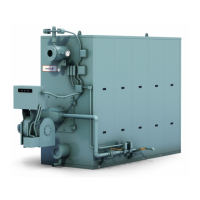
